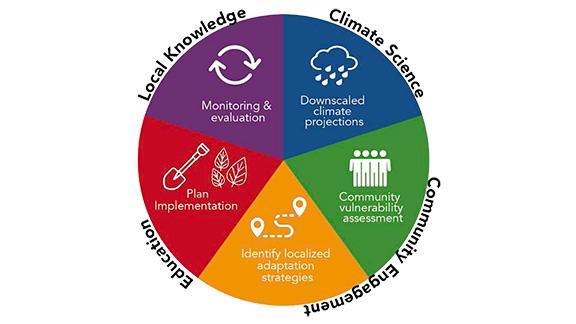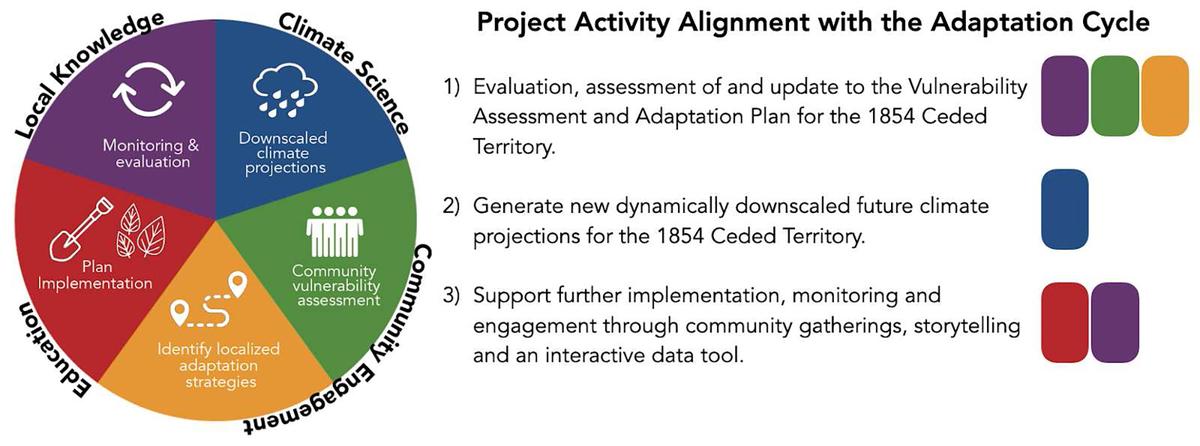
Project description
INTRODUCTION
This collaborative project seeks to bring together a range of expertise and perspectives to assess and evaluate progress toward climate resilience across the 1854 Ceded Territory and to use this knowledge to co-develop an updated adaptation plan for the 1854 Treaty Authority and the Bois Forte, Grand Portage, and Fond du Lac reservations that incorporates different knowledge (e.g. climate data and tribal observations and stories) and fosters relationships required to develop knowledge and resources that are both useful and used.
Abstract. Managing Minnesota’s aquatic and natural resources in a changing climate requires data, trusted partnerships, and the capacity to engage in continuous dialogue and learning about how climate changes are translating into climate impacts on ecosystems and people — and critically to understand the efficacy of actions intended to enhance climate resilience. This continuous, iterative nature of climate adaptation affords rich opportunities for knowledge sharing, monitoring, and evaluation of the characteristics, approaches and outcomes that lead to climate resilience. In the Midwest, many Tribes and Inter-Tribal entities are leaders in climate adaptation and are well into the implementation phase of their first adaptation plans, providing an opportunity to explore how and the extent to which resilience is being achieved through different adaptation strategies intended to protect ecosystem and cultural resources. In Northern Minnesota, the 1854 Treaty Authority and Bois Forte, Fond du Lac and Grand Portage Bands have six years of implementation experience following their plan release in 2016 and they are prepared to update this plan, incorporate new knowledge and evaluate progress toward resilience.
The project team will:
- Evaluate progress, barriers to, and opportunities for adaptation following this period of implementation;
- Generate dynamically downscaled future climate projections for the 1854 Ceded Territory and incorporate these into an updated adaptation plan; and
- Co-produce an interactive data tool to share these data with tribal members, resource managers and other adaptation professionals in tandem with community engagement efforts designed to showcase the region’s progress toward community and ecosystem climate resilience.
HYPOTHESES AND OBJECTIVES
Accelerating adaptation and tracking progress toward climate resilience requires monitoring, periodic evaluation and clearly defined metrics against which strategies can be measured (e.g. Arnott et al. 2016). Nearly all adaptation plans in place today have monitoring and evaluation as critical components (figure above), yet few examples exist for how to integrate and apply any monitoring or evaluation outcomes into updated plans or for measuring success following a sustained period of implementation (e.g. Abt Associates, 2016).
- Further, how can new climate change information, community knowledge and other climate-resilience-related information be integrated into updates of adaptation plans to reflect successes, barriers and shifting community priorities?
- What lessons can be gleaned from adaptation implementation and how can these be effectively communicated to tribal members, resource managers and other practitioners and community members working to build climate resilience in their communities?
Based on over six years of implementation experience, this project will address these questions as they relate to the management of cultural and natural resources across the 1854 Ceded Territory in order to:
- Understand and document successes, challenges and barriers to adaptation across the 1854 Ceded Territory and explore how to measure and communicate about progress towards climate resilience as outlined in the over 100 adaptation-related strategies in Stults et al. (2016);
- Generate future climate change information for key climatic variables and lakes across the 1854 Ceded Territory and incorporate this information into an updated vulnerability assessment and adaptation plan.
- Develop an interactive online visualization and in-person knowledge-sharing opportunities to communicate this climate change-related knowledge to help accelerate regional resilience.
ECONOMIC BENEFITS
The project will position the 1854 Treaty Authority to leverage resources and investments in support of resilience activities that are becoming more readily available through state and federal funding opportunities. And, through increasing access to, and dissemination of, fundamental future climate data for the Lake Superior region this project has the potential to inform a range of decisions and investments seeking to be climate-ready. Advancing the understanding of adaptation plan development and monitoring and evaluation may help to strengthen and streamline adaptation planning investments being made in other parts of the state and the Great Lakes region.
USEFULNESS
The project team anticipates that this project will provide data, methods, and an evaluative framework for adaptation assessment that can be used by other Tribes, inter-Tribal entities, and adaptation practitioners. This project should be a strategic investment that can help advance the state of Minnesota’s climate work. The downscaled climate data and the corresponding data tool will serve as a proof of concept to support a broader, statewide effort to generate data for the entire state. The project team plans to make the climate data available for use by other researchers for input into other models (e.g., groundwater) and applications. The project aims to advance the field of adaptation and provide foundational knowledge that can be applied in other climate resilience and research applications.
OUTCOMES
The project is expected to result in several key deliverables that will advance climate adaptation and resilience efforts across Northern Minnesota. The deliverables include:
- An evaluation framework and synthesis of progress towards resilience and adaptation across the 1854 Ceded Territory.
- First-of-their-kind climate projection data for this region and a corresponding interactive data tool to enable easy access and broad use of these data.
- A fully updated and co-produced adaptation plan and vulnerability assessment that incorporates these new future climate data and builds on tribal investments and priorities that have emerged over the last 6 years.
- A new partnership between climate researchers, natural resource managers and tribal governments.
- A suite of communication resources tailored for audiences who reside, recreate in, or manage resources across the 1854 Ceded Territory.
Outreach plan
The project team will conduct outreach to share project progress and outcomes with a broader audience of tribal and non-tribal members.
Goal. The overarching goal of project communications work is to enhance, amplify and catalyze conversations and engagement around climate change and adaptation across Northern Minnesota. Communications activities will be captured and managed through a comprehensive strategy that includes clear goals, audiences, activities and evaluation (designed after Salmon and Roop, 2019).
Deliverables. The project team will produce a range of written project summaries, visual narratives and stories on climate change and climate impacts across the 1854 Ceded Territory. One key step in the operationalization of the adaptation plan is sharing successes and celebrating progress, and the project team aims to use these types of communication resources to capture and share these adaptation success stories. The project team will work with LightHawk, a conservation non-profit, to collect aerial images of the region for visualization in our communications products to support the mutual goal of catalyzing conservation efforts and community engagement. These assets will be incorporated into web, print and communications resources for tribal and non-tribal audiences. The project team will include closed-captioning where needed and use alt-text for photographs or other visual assets to support accessibility of deliverables. They will also translate a range of these materials into Anishinaabemowin.
Key seasonal community events identified by the 1854 Treaty Authority for distributing these resources include SaaGiiBahGaa, Nett Lake Powwow, the Grand Portage Health Fair, the Vermilion Powwow, Grand Portage Rendezvous Days and Powwow, and the Nett Lake Miigwech Manoomin Powwow. These materials will also be available at tribal natural resource offices and for download from the 1854 Treaty Authority’s website and UMN Extension’s climate website (and other sites as desired).
Media, seminars, webinars. The team will also share approved project summaries and learnings throughout the project lifecycle using social media and through webinars and community gatherings including the Minnesota Climate Adaptation Partnership’s monthly webinar series, Minnesota Sea Grant’s Twin Ports Climate Conversations, and through KBF2 Bois Forte Public Radio, and the Bois Forte Conservation Committee.
Non-tribal target audiences. The target non-tribal audiences will be other adaptation practitioners and natural resource managers, community leaders and elected officials working on climate change resilience efforts and State and Federal agency staff working on coastal resources management and research in the region.
Conferences. The team plans to share this work at the annual Minnesota Climate Adaptation Conference and at relevant professional conferences like the National Adaptation Forum and Native American Fish and Wildlife Society Conference. Engagement across the Northern Lake Superior region will include an in-person regional stakeholder engagement workshop for practitioners and natural resource managers in the greater Lake Superior region. This 45-person gathering will be held in Duluth at the 1854 Treaty Authority Offices in late 2023 to showcase the key project learnings for adaptation planning and evaluation and will serve to increase awareness of the availability of, and uses for, the downscaled climate data. The project team will invite city and county leaders, Sea Grant staff, MN DNR coastal program staff, University researchers, and other regional adaptation practitioners to this gathering.
Funding
Support for this project is provided by Minnesota Sea Grant’s 2022-2024 Biennial Request for Proposal program. Every two years MNSG awards approximately $2 million in research grants through a rigorous, competitive, peer-reviewed process. Researchers based in Minnesota, who are not federal employees, are invited to apply. Grant awards average about $45,000 per year for two years, plus a graduate research associate whose cost does not count against the project budget.
Why Sea Grant?
Managing Minnesota’s aquatic and natural resources in a changing climate requires data, trusted partnerships and capacity for incorporating climate information into decision-making. The project team’s collaboration among tribal members, natural resource managers, university researchers, extension professionals, and students seeks to bring together diverse perspectives and expertise to characterize the impact of adaptation actions across the 1854 Ceded Territory. The project aims to provide new knowledge and information that can examine effective interventions and strategies for natural and aquatic resource management that enhance community, ecosystem, and economic resilience across the Northern Lake Superior region. The project team states that this work supports Minnesota Sea Grant’s vision to promote a present and future where citizens use science-based understandings of the environment to address issues concerning Lake Superior and Minnesota's aquatic resources and associated economies through inclusion and engagement of the diverse communities of Minnesota.
Project Team
Principal Investigator:
Heidi A. Roop
hroop@umn.edu
Assistant Professor and Extension Specialist for Climate Science
Department of Soil, Water, and Climate
University of Minnesota
Co-PIs:
Elise Harrington
Stefan Liess
Hilarie Sorensen
Tracy Twine
Collaborators:
Ryan Noe
Bryan Runck
Graduate Research Assistant
Erik Simula
Lead scientist(s)
Heidi A. Roop
hroop@umn.edu
Assistant Professor and Extension Specialist for Climate Science
Department of Soil, Water, and Climate
University of Minnesota
